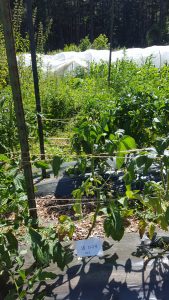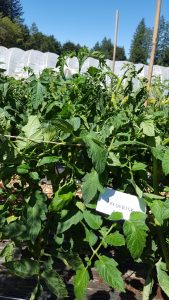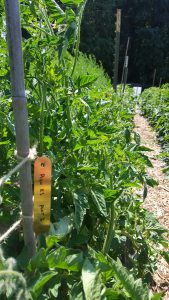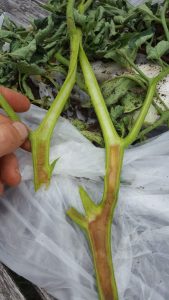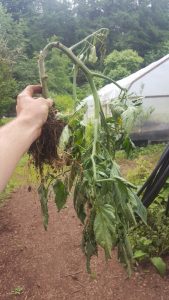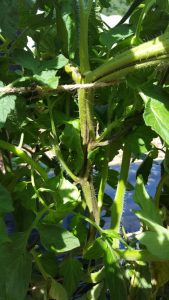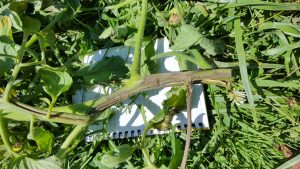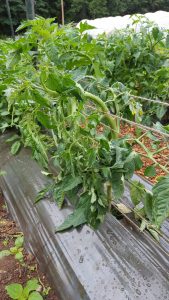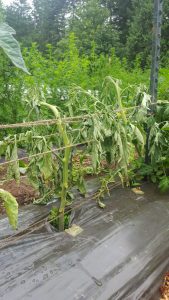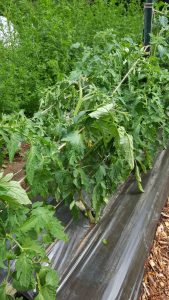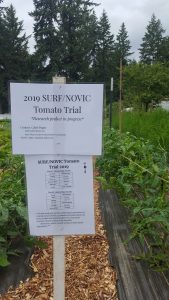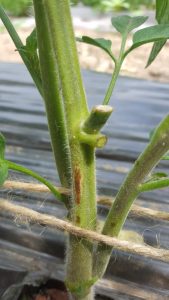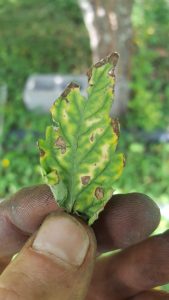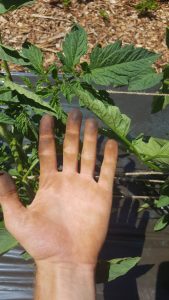Finally, the summer weather has arrived to our little corner of the Pacific Northwest. Temperatures in the mid 80s all week and low humidity have given the tomatoes a much needed rest from fungal/moisture stress. During this weather, a few of the plants that were showing signs of heavy stress have made some slight recovery and nearly all of the plants have fruit of varying size on their branches (all except for a the LB 21-7-4 variety) that continue to get slightly bigger every week.
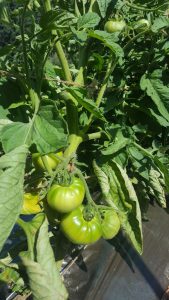
Some JTO 1021 fruit!
That being said, there are still some plants that are not recovering as gracefully as I would hope. Here I will go over the plants that have shown little improvement, or have shown a regression in health:
- The Crimson Sprinter plants, #2 and #4 of plot 2 still appear to be struggling heavily with what I think could be Bacterial Wilt. These plants haven’t shown any vigor for weeks and the few fruit that are on plants have remained small and stunted, similarly to the plant they sit upon. C.S. #1 of plot 2 looks much healthier than the others but still much smaller when compared to the other plants. (I must remember that this is the only semi-determinate variety in the trial and may behave differently when compared to the others.)
- Pilu KS, plot 1 #1, and #2, are both thin and weak and aren’t producing a lot of fruit but have continued growing and don’t look as notably wilted as they have in the past. While these may produce a few ripe fruit, I expect the yield to suffer because of it’s ailment.
- Frederick, plot 1, #1 is looking quite unhealthy. The plant is not only a full foot shorter than the others of it’s variety, it is also heavily wilted and has yellowed leaves at it’s base that were removed from the plant and the plot. The plant looks very similar to the two sick Crimson Sprinters in plot 2. There is a nice comparison to be made between the unhealthy and healthy plants of the same variety standing right next to each other, there is a clear distinction between what a sick plant should look like when healthy. (The photo I took was blurry and will need to be retaken)
- LB 21-7-4, *all plants in both plots* – This variety has struggled through the entirety of the trial. While the plants in plot 2 look slightly healthier (bigger) than those of plot 1, all of them are small and spindly. Rather than producing many leaves and leaflets, this variety seems to focus on growing large ‘Burdock-style leaves’ that needed to be pruned once the leaves showed signs of Early Blight, leaving few photosynthetic sites for the plant. This mixed with a cloudy and wet summer, and perhaps some plant genetics has left the LB 21-7-4 behind the other varieties, at least this is my hypothesis as to why this variety could be smaller and weaker than the other varieties. (Below you can compare the LB 21-7-4 to a Frederick, both are indeterminate)
I want to also briefly catch you all up on the plants that had been showing some strange new symptoms of a new disease. I had written about how the stem of 4 different plants had been infected and looked necrotic, from those observations I have guessed that the plants suffer from what is called Pith Necrosis, Pseudomonas corrugata. The truth of this disease will hopefully be identified once the pathology results return from the plant that I sent to the lab. I observed today that the disease has not continued to spread to surrounding branches of the tomato plants. The stems that were afflicted were removed, but the remaining stems still look healthy and vigorous. (Good news!) I will continue keeping a close eye on the plants showing signs of this necrosis.
Aside from these observations, I did some plot maintenance that included weeding and trellising the ever growing tomatoes and took another round of leaf curl observations. The plot is looking full and it is only a matter of weeks until the first ripe fruit will be in my hands.
Have a great week and I will do the same.

